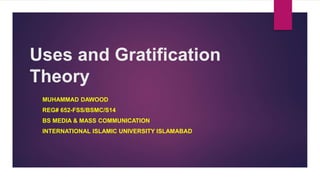
Uses and gratification theory
- 1. Uses and Gratification Theory MUHAMMAD DAWOOD REG# 652-FSS/BSMC/S14 BS MEDIA & MASS COMMUNICATION INTERNATIONAL ISLAMIC UNIVERSITY ISLAMABAD
- 2. Uses and Gratification Theory Definition: “The Uses and Gratification theory explains why and on what basis select the media. It states that people have certain predefined needs and in order to fulfill those needs, they seek gratification from media. Media caters to the information and entertainment requirements of the audiences. The theory assumes that the audience is proactive while making a search for any specific media be it television, radio, internet, newspapers or any other media form”.
- 3. Uses and Gratification Theory UGT argues that people actively seek out specific media and specific content to obtain specific gratifications or results. 1. UGT views people as active because they are able to examine and evaluate various types of media to accomplish communication goals. 2. UGT researchers ask “What do people do with media?’ instead of “What do media do to people?”
- 4. Uses and Gratification Theory It was further developed by Katz, Blumler and Gurevitch in the 1970s. According to Katz, Blumler and Gurevitch's research there were some components comprising the Uses and Gratifications Model including active audience, audience initiated media choices and media competing with other sources of satisfaction. They also proposed several needs for media consumption which are classified into following five categories: 1. Cognitive Needs: Media is used by people for acquiring information and knowledge. It is also used to develop better understanding of various concepts and issues, for example people watching documentaries, news analysis reports on current affairs etc.
- 5. Uses and Gratification Theory 2. Affective Needs: People use media for seeking pleasure or to satisfy emotional needs, for example, watching music videos, movies, soap operas etc. 3. Personal Integrative Needs: Sometimes we use media to acquire credibility and reassure our status. This is the self-esteem need, for example people get to improve their status by watching media advertisements and buy products to change their life style and media helps them to do so. 4. Social Integrative Needs: Internet and social media are normally used to satisfy this need which is to integrate and connect with family or friends, for example, using e-mails, chat rooms or Facebook to link up and socialize. 5. Tension Release Needs: Media is used for catharsis i.e., for the release of pent-up emotions as this provides some relief and relaxation. It is also used as a medium of diversion from the routine life and for escapism, for example, watching comedy movies, reading novels, comics etc.
- 6. Comparison of UGT with other theories UGT can be distinguished from other theories such as Agenda setting or Bullet theory on the basis of following points: 1. In UGT the audience remains active, while other theories considers the audience passive. 2. In UGT the audience comes first, while according to other theories the media comes first. 3. UGT provides for the choices of audience, while other theories gives priority to media where the audiences remain secondary.
- 7. Opinion In nutshell, from the above discussion I would like to suggest that UGT is the best theory both in its content and form. Because it fulfill all the essential purposes of media research and observations. I choose to prefer the UGT on the basis of the reason that, it is more fruitful than other theories, as it seeks to gather information from the audience which are the real sources of data. It directly goes to the roots of the media, because without audience media has no importance. It is the audience which can guide media and media persons to formulate new policies. Nevertheless, other theories are also relevant in this context, but UGT according to my viewpoint is the best.
- 8. Priming Theory Introduction Media effects refer to how mass media affects its audience in decision making. Priming is considered as the predecessor of agenda setting, one of the theories of media effects. Priming has its base in cognitive psychology which relates to associative network model of human memory. This concept details how one thought may generate associated thoughts.
- 9. Priming Theory Priming is a concept through which the media effects among the people are enhanced by providing a basic perception human minds take decisions based on the preconceptions that are already been stored in our memory. The memories are stored as a form of nodes and they are interconnected effectively and mostly act as a frame of reference to the decisions that we make. Priming enables the audience to evaluate the situation and to conclude how effective the media have been in order to make a decision by providing a frame of reference. Thus media creates an influence among people to make judgment or a decision.
- 12. THANK YOU